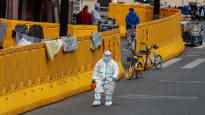China is trying to crack down on the omicron. Finns living in Shanghai call action absurd and distressing.
Authorities have ordered 26 million people in Shanghai for severe isolation due to rapidly spreading coronavirus infections.
Shanghai is one of the largest cities in the world and known as the driving force of the Chinese economy. The lockout of a million city will have a major impact on both the Chinese and global economies.
The eastern side of the city of Pudong was closed on Monday. The closure will run until Friday, April 1, when the western side of the Puxi River, which crosses Shanghai, will be closed.
Puxi is home to a popular tourist area in the Bund, among other places.
During isolation, all non-essential shops and factories are closed. Among other things, Tesla has closed its car plant.
Bridges and tunnels are closed and no taxis or public transport are available. According to the authorities, airports, railway stations and freight traffic are still operational.
One infection quarantines an entire suburb
Sanna Korsström lives with his family east of Pudong. They have been quarantined in a gated residential area since last Wednesday.
– Our residential area has been in a lockdown because there was one infection in a small residential area less than a kilometer away, Korsström says by phone.
This reflects China’s zero tolerance: the country wants to stifle a single coronavirus infection.
During isolation, Korsström’s family, like other townspeople, is subjected to coronavirus testing. Every Shanghai resident is tested at least twice.
Korsström had had time to buy food for the warehouse in advance, as individual residential houses and suburbs in Shanghai have been isolated for weeks after omikron began to spread in the city.
– I haven’t had the food ordered home for four days now. All order programs are stuck and order backlogs are naturally lacking, Korsström sighs.
Known for its high-rise building skyline, Shanghai is deserted in many places. Only distributors of food and other supplies are currently allowed to move east. Supervisors wearing white protective suits guard the streets outside.
Executive Director of the Finland Business Council, which promotes the operations of Finnish companies in Shanghai Hanna Osara still able to move because he resides on the west side of town. However, strict corona precautions do not entice you to leave.
– The atmosphere is apea. Many shops are closed, restaurants are closed. It’s pretty quiet on the streets, he describes.
People panicked into the trade
Authorities did not announce the closure, which begins Monday, until late Sunday night. The announcement caused panic in Shanghai.
Residents rushed to the shops to hoard food and other supplies.
They were shocked because local authorities had previously promised that the entire city would not be isolated. Authorities had said that Shanghai is such a major economic center that closing it would cause huge problems.
In Shanghai, only isolated buildings and neighborhoods had previously been closed and residents urged to work remotely.
Among other things, the city is one of the most important ports in the world for cargo from all over the world.
On Monday, Wu told reporters that complete suppression of latent infections is still necessary.
“It is necessary to take determined and firm action to reduce social mobility and find those infected,” Wu said.
According to Hanna Osara, the closure will also affect Finnish companies. He says he spoke to one company that had already suffered from Shanghai’s previous regional closures.
– Even before these lockdowns, a third of the company was out of line, Osara says.
Minor infections, massive actions
Shanghai infection rates have risen to the highest in China. On Sunday, a record more than 3,500 infections were found in the city.
Most of them were asymptomatic – only 50 people had symptoms.
There were 6,215 new cases of corona in all of China on Sunday, most of them asymptomatic.
Shanghai’s precautions are massive compared to the rest of the world.
– Personally, it feels pretty absurd. But when you see what happens in other cities, this is pretty logical, Hanna Osara smiles.
At the start of the pandemic, Wuhan, with a population of 11 million, was under strict quarantine for 76 days. After that, China was able to dam the infections for a long time. They were detected at their highest level in just a dozen days, even though there are 1.4 billion people in the country.
However, China has not stopped the Omikron variant, even though it has quarantined tens of millions of people in recent weeks. The millions of cities in Xi’an and Shenzhen, among others, have been isolated.
Sanna Korsström says quarantine is distressing and unnecessary.
– I feel that zero tolerance is an impossible task. The consequences of fighting and treating the affected people are terribly difficult for a Westerner to understand, he says.
Getting a positive test result is a scary idea for Korsström. He is particularly concerned that all those infected, whether symptomatic or not, will be isolated.
The asymptomatic ones have their own reception centers built up, and the symptomatic ones end up in hospitals. Authorities even separate children from their parents.
Citizens’ anxiety is popping up on China’s social media.
For example, people have hardly updated the fate of an asthmatic nurse. The nurse was unable to access the hospital where she worked because the first aid ward was closed due to disinfection associated with coronary infections. He died on the way to another, nearest hospital.
People report on social media that their family members have difficulty accessing care other than their corona.
Pudong’s isolation should end on Friday, but Sanna Korsström is not yet afraid to trust it.
– It is not known whether there will be positive test results in our residential area. So what’s the next step? I am very skeptical, he says.
You can discuss this topic until Tuesday, March 29 at 11 p.m.
